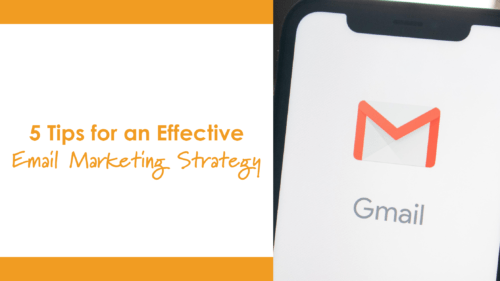
5 Tips for an Effective Email Marketing Strategy

Email marketing offers an effective, inexpensive, and uninterrupted way to connect directly with your audience right in their inbox. Using email marketing, you can create and distribute compelling campaigns that encourage customers or guests to buy, visit, and engage with your business.
Now more than ever, as we continue to navigate the COVID-19 pandemic, email marketing is a very important component to include in your overall digital marketing strategy. In fact, according to CampaignMonitor.com, an article indicated that “more people are opening email during the COVID-19 pandemic than ever before.”
Read on to learn more about five tips for enacting an effective email marketing strategy for your business.
1. Always Adhere to Best Practices
First and foremost, ensure your email template is branded appropriately to reflect your business’ brand (logo, colors, fonts, etc.) and voice (writing style). It should be an accurate representation of your company and closely mirror other designs and marketing collateral produced by your business or organization. Templates can be created easily and distributed using low-cost tools such as MailChimp or Constant Contact.
Employ compelling subject lines and preview text that will grab your audience’s attention – you want them to be interested and open your message. It’s also important that the content within aligns with your brand/company/industry and provides some sort of value to the reader.
Further, be mindful of timing – I.E. the best day of the week and time of day to send your email campaigns. Best practice has indicated that Tuesdays, Wednesdays, and Thursdays in the morning are optimal times to distribute but this can vary based on your business and audience. We’ll further address ways you can test distribution times to help determine what works best.
Lastly, make sure to always comply with CAN-SPAM laws. If broken, you can be “black-listed” from sending email distributions and incur fines.
2. Segment Your Audience
Sometimes, as with a general monthly newsletter, you can send your email campaign to everyone on your list (who, of course, has opted-in). However, sometimes, not all content is meant for or appropriate for all subscribers. For example, if you’re offering a special deal for loyalty customers only, you’ll want to send that campaign to the list that consists of just your loyal patrons.
Actively monitoring your subscribers and categorizing them into various lists should be an integral and routine part of your email marketing strategy. Doing so can also help improve your email campaigns and achieve better results.
It’s easy to get hung up on email list growth and having a large audience but it doesn’t always prove to be beneficial. Pay careful attention to emails that bounce back and remove them from your lists accordingly. The most important part of your list measurement is engagement. What good does it do you if have 50,000 subscribers but only 50 who open your emails or click on your content? Think quality over quantity.
3. Conduct A/B Tests
A/B tests, or split testing, should be conducted frequently to help improve your email marketing campaigns. This involves creating two versions of your campaign and sending one variation to one subset of your subscribers while the other subset receives the second version/variation. The end goal is to review and determine which version performed best.
As you conduct A/B tests, you’ll start to notice trends and patterns that will enable you to make adjustments along with other improvements and updates, so your emails are more effective.
For instance, these tests can help you define the best day of the week and time of day to send campaigns, as well as determine content and call to actions that are resonating best with your audience. Some other elements to consider testing include the from line, subject line, and preview text. It may also be helpful to focus on testing only one thing at a time.
4. Ensure Mobile Friendliness
With an increasing number of people viewing email on their smartphones and/or other mobile devices, it’s crucial to ensure your email campaigns are mobile friendly and optimized for a mobile audience. If emails aren’t mobile-friendly you run the risk of readers deleting your message or unsubscribing regardless of the quality of content.
In order to help ensure your email is mobile-friendly, be concise as much as possible. For example, keep subject lines on the shorter side as fewer characters appear as the preview on mobile devices. The content within should communicate clear messages/call to actions and focus on the essentials when it comes to design. You should stick with using a simple, single column template rather than a multi-column layout. A single column layout will be easier for users to navigate and will help limit zooming, scrolling, etc.
In advance of scheduling your campaign for distribution, be sure to send a test email and view it on different devices – I.E. desktop computer, smartphone, tablet, etc. This way you can be sure it appears the way you intended it to look.
5. Leverage Tracking Metrics
Via email marketing platforms such as MailChimp and Constant Contact you can obtain detailed tracking or performance data and other useful information. After the distribution of a campaign, it’s important to review these reporting details as a way to help optimize your email campaigns in the future.
For example, here are some email marketing metrics you should pay close attention to:
- Open rate
This simple metric shows you just that – how many of your email subscribers opened the email. The open rate is key to understanding if your audience is interested in what you’re sending.
- Click-through rate (CTR)
CTR is another popular metric, it provides the number of people who have clicked on links within your email. This tells you of those who were interested enough to open your email, how many of them took the desired action and clicked on your content to learn more, sign up, etc.
- Conversion rate
This metric is similar to CTR in that it measures the number of people who clicked on links within in your email. However, the conversion aspect helps determine how many people completed an action – I.E. purchase of an item from your online store, signed up for your event, etc.
- Bounce rate
The bounce rate will show you the number of email addresses that didn’t receive your email message due to no longer being active, input wrong, etc. As touched upon earlier, you can use this information to update and keep your email lists current.
- Unsubscribes
You should also keep track of the number of people who unsubscribe from your emails. While it can be discouraging to note the number of unsubscribes, understand that not everyone likes to receive content or interact with brands this way. It will also help you fine-tune your email lists too.
Be sure to use tracking links/UTM codes too. This will help determine which leads to your website are being driven by your email campaigns and by which part Instead of just learning how many people went to your site from your email, you can determine what content specifically drove them to action (which article block, call to action, etc.). For more information about UTM codes and how to create and analyze them, click here.
Email marketing is efficient, cost-effective, and provides valuable return on investment (ROI) for your company. By referencing these five tips for enacting an effective email strategy, you can maximize your overall marketing strategy and drive more business, web leads, etc. to increase revenue.
For more information on how PTE can help you with your email marketing strategy, contact us.
You May Like

The Importance of Setting Goals - for Career Success
Recently we had the opportunity to attend The Blue Chip Awards Luncheon. A wonderful afternoon filled with successful small business people, great food and inspirational stories, the highlight was key speaker, Nikki Stone. An Olympic gold medalist, Nikki overcame much adversity and physical challenges throughout her career and stressed the

Public Relations Strategy - 10 Steps to Ensure Success
As many of you know, I earned my APR (Accreditation in Public Relations) last year. Quite the process, I learned far more than I thought via studying assigned literature. One such piece, Cutlip & Center's Effective Public Relations 10th edition (EPR 10) was invaluable. Having practiced public relations for large

Networking: For Business and PR
Networking and communication used to take the traditional path of print advertising and brochures, direct mail, local/national trade shows, etc. These forms of communicating your brand/business still exist but more often they are used in balance with modern forms of networking and sharing information about you and your business. Here